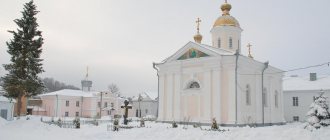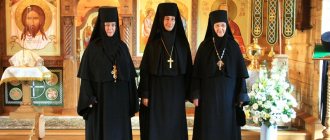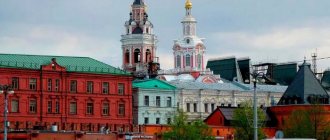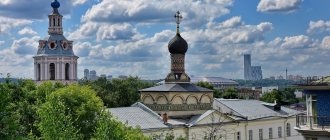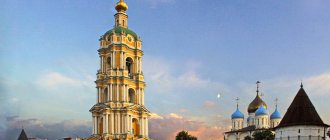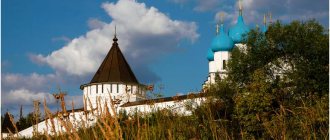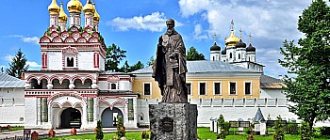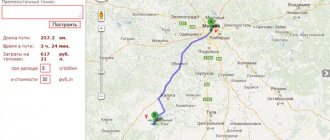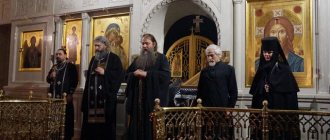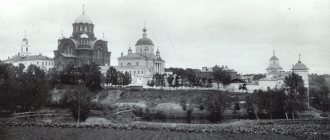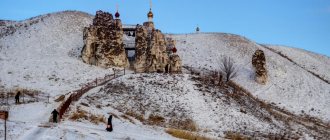Schedule of services of Anosin Boris and Gleb Monastery
The nuns of the monastery read the Indefatigable Psalter around the clock. They remember the peace and health of Orthodox Christians. On weekdays, the nuns of the monastery begin to pray at 6 am. Also in the Trinity Cathedral there are services for parishioners:
- on weekdays and Saturdays - Divine Liturgy at 8:00 and evening service at 17:00;
- on Sundays and holidays - at 6:30 and 8:45.
During Lent, services are held at 7:00 and 17:00. On Wednesday and Friday the Liturgy of the Presanctified Gifts is held.
Schedule of services on the official website of the monastery
© Margarita Kushnirenko
Confession is held after the evening service. In the morning, only the infirm and parishioners with small children can get there. Prayer during the service before Communion is obligatory.
If the location of the service changes, parishioners are informed about this by an announcement on a special board near the church.
Patronal feast days in the monastery are accompanied by a religious procession. The main events fall on May 15, August 18 and 28, October 4, November 10 and the 50th day after Easter. The religious procession is also held on October 1, the opening day of the monastery.
The sisters carry out obediences every day: they care for animals, grow garden crops, make cottage cheese, cheeses, sour cream and other products from cows’ milk, and bake the famous Anosinsky bread.
© Margarita Kushnirenko
Modernity
Today, the Borisoglebsky Anosin Monastery is experiencing another period of prosperity. The nuns carry out spiritual service, work on a large farm and welcome numerous pilgrims and tourists within their walls.
Architectural ensemble
The main religious buildings were erected in the first half of the 19th century. After 70 years of oblivion and destruction, the monastery churches were rebuilt and re-consecrated. The following religious buildings function on the territory of the monastic community in Anosino:
- The oldest building of the Borisoglebsk monastery is the Trinity Cathedral, erected in 1812. The temple, made in the style of classicism, consists of the main part, which is a round rotunda, adjacent to a semicircular apse, a refectory part and an elegant bell tower. The rotunda is covered with a hemispherical dome topped with a small turret. At its base there is a lucarne belt. In the refectory there are two chapels in the name of the Dormition of the Mother of God and Saints Boris and Gleb. In the upper part of the three-tier bell tower, erected above the western vestibule, there is a belfry. The facades of the building are decorated with snow-white rustics, sandstones and cornices. The interior walls and vaults are covered with paintings and icons.
- Part of the northern wall of the city fence is the chapel of St. Dmitry of Rostov. It was built in 1824. The building is a pillarless temple, adjacent to which is a small refectory and a semicircular apse.
Iconostasis of the Church of Demetrius, Metropolitan of Rostov, in the Boris and Gleb MonasteryLike the main monastery church, the chapel is decorated with snow-white architectural decorative elements. During the pre-revolutionary heyday, private services were held in the temple. The modern history of monastic services began in this small church.
- The temple in the name of St. Anastasia the Pattern Maker is located in the northern part of the monastery property next to the hospital building. The temple, erected in honor of the daughter of the founder of the monastery, was consecrated in 1829. The square, pillarless temple is covered with a hipped roof, topped with a round rotunda with a spherical dome. The red facades of the building are decorated with white decorative details. The ceremony of the great consecration of the restored building was held in November 2013.
In addition to religious buildings, on the territory of the modern monastery there are residential and administrative buildings, outbuildings and artificial ponds.
Schedule of services
The nuns of the Borisoglebsky Anosin Monastery read the Inexhaustible Psalter around the clock with remembrance of the health and repose of Orthodox Christians. In addition, religious services are held daily according to the following schedule:
- Monday through Saturday services are held at 8 a.m. and 5 p.m.;
- on Sundays and holidays services are held at 6.30 and 8.45;
- On patronal feast days, a procession of the cross takes place around the monastery territory.
Divine service in the Trinity Cathedral of the monastery
The patronal holidays of the monastery are the following days:
- Trinity Day is the 50th day after the Holy Resurrection of Christ;
- Assumption of the Blessed Virgin Mary - August 28;
- commemoration of Saints Boris and Gleb - May 15 and August 18;
- days of memory of St. Dmitry of Rostov - October 4, November 10;
- commemoration of the Great Martyr Anastasia the Pattern Maker.
Interesting: on weekdays, morning prayers for nuns begin at 6 am.
Social activity
The nuns of the Borisoglebsky Monastery, located in the village of Anosino, carry out active social activities, which include the following:
- The monastery has a shelter for orphan girls.
- A Sunday school for children and adults operates at the monastery. Young students study the Word of God, and also develop their creative abilities under the guidance of specialists working in the monastery school on a voluntary basis. With adults, clergy discuss the main issues of the Christian Faith and Orthodoxy.
- The nuns correspond with people in prison, providing them with spiritual support.
- Frequent guests of the monastery are pupils of children's social institutions in the Moscow region.
Temple image on the apse of the Church of Demetrius, Metropolitan of Rostov
Tourist excursions and pilgrimage trips are also organized to the monastery, during which you can see and worship the many shrines collected within the walls of the monastery churches. These include:
- Tikhvin Icon of the Mother of God;
- icon of the Assumption of the Blessed Virgin Mary;
- image of Demetrius of Rostov with a particle of relics;
- relics of Saints Boris and Gleb;
- reliquary with particles of the relics of many saints.
History of the Anosin Monastery
In 1799, Evdokia Nikolaevna Meshcherskaya (nee Tyutcheva, aunt of the poet Fyodor Tyutchev) acquired the village of Anosino, on the banks of the Istra River. Already in 1810, she received the blessing of the Moscow Metropolitan to create the Church of the Life-Giving Trinity. In memory of her late husband Boris, Evdokia consecrated the chapel of the church in honor of Saints Boris and Gleb.
In 1820, an almshouse was formed at the temple, where 11 women began to live. Already in 1822, it was converted into a women's dormitory named after Boris and Gleb, whose trustee was Evdokia Meshcherskaya. A year later, the community became a monastery, and Evdokia took monastic vows and became Abbess Evgenia.
© Margarita Kushnirenko
A strict Ionic rule was established in the community. Saint Philaret became the mentor. Strangers could not enter his territory, and nuns could not leave it. Alms were not collected and things from the world were not accepted. Due to the strictness of the charter, the monastery began to be called Optina Hermitage.
Sinners began to be brought here for repentance and correction: those who abused alcohol, committed adultery, and also performed rituals according to the old style. The abbess did not approve of this practice, but were forced to accept novices.
Until February 1837, the monastery was managed by Abbess Evgenia. Then her earthly journey ended. She is buried at the northern aisle of the Church of the Life-Giving Trinity.
For the next 20 years, the monastery was ruled by Abbess Anastasia. She was the goddaughter and pupil of Evgenia, and before that the serf princess Meshcherskaya. After her departure to the Serpukhov Master Monastery, the granddaughter of Evdokia-Evgenia, who also took the name Evgenia after tonsure, became abbess and ruled the monastery until 1875. After her transfer to Moscow to the Passionate Monastery, nun Raphaila became her successor.
© Margarita Kushnirenko
Since 1879, Mother Ionanna was the abbess. She managed the monastery until her death at the age of 90. She was the strict abbess herself, and she herself strictly observed the rules. Schema-Hegumen German, the elder of Zosima Hermitage, often came to talk to her. According to contemporaries, he believed that he could “learn monasticism” from Mother Joanna.
Until 1928, the monastery existed as a monastery. Due to high taxes, the nuns had to work hard and sell their products. Back in 1917, there were 180 nuns here, and then only 130 sisters remained in the monastery.
In 1928, the current abbess Alipia was arrested along with several sisters. They were sent to labor camps, and the rest of the women were simply kicked out of the monastery. The monastery was used as an agricultural commune until its food supplies ran out. Valuable things and shrines began to be exported back in 1922, and the bells were melted down.
Panorama of the Anosin Boris and Gleb Monastery on Yandex maps
The Church of St. Anastasia was first converted into a club and then a residential barracks. Dmitrovsky Church worked as a store. The war hit the bell tower and the Trinity Cathedral so much that only part of the temple was preserved, which was used to repair agricultural machinery.
Restoration of the monastery began in 1992 at the request of Schema-nun Anna to His Holiness the Patriarch. Until 1999, this was the patriarchal courtyard. But in the winter of the same year, the status of a monastery was returned to it, and stauropegial, which means subordination to the patriarch himself.
Women from the Trinity Monastery in Riga settled here, the founder of which was Sergia, the spiritual daughter of Abbess Eugenia, the granddaughter of the founder of the Church of the Life-Giving Trinity in Anosino. And since 2005, Abbess Maria has been in charge here.
© Margarita Kushnirenko
The first church to be built in the monastery was the Church of St. Dmitry of Rostov
At the entrance to the monastery, on the left hand is the Church of St. Dmitry of Rostov. It became the first monastery building. The church right at the gate was very convenient for parishioners, because lay people were allowed into the monastery territory only during the Liturgy.
In 1884, the temple was insulated and received a gilded cross.
After the monastery was closed and destroyed, the building was used as a store and later a warehouse.
A sign was mounted into the wall of the former church with the inscription “Mossovet Geo-office” and a number. The building was in disrepair, however, after the revival and opening of the monastery, the first divine services were held here.
After the restoration of the Trinity Cathedral, the church was closed for major repairs.
The first monastery building, Church of St. Dmitry of Rostov
On October 4, 2012, on the day of memory of the Most Holy Dmitry of Rostov, a festive Liturgy took place for the first time in the renovated church of the same name. On the eve of the opening, in 2011, the church was presented with an icon of St. Dmitry and a particle of his relics, revered shrines within the walls of the Boris and Gleb Monastery.
On March 30, 2013, the church premises were consecrated by Archbishop of Sergievo-Posad Feognost.
During the day the temple is open to parishioners, and at night Liturgies are celebrated for the sisters.
Buildings on the territory
During the reign of Abbess Eugenia, the main buildings were erected on the territory of the monastery. This is a fence with holy gates, the chapel of St. Dmitry of Rostov, stone cells for nuns, the Church of Anastasia the Pattern Maker, a hospital building, a grain barn, a workshop building, and a refectory. To provide the residents with food, 2 fish ponds and a garden were organized on the territory.
By the end of the 19th century. The monastery underwent reconstruction of existing buildings and construction of new ones. It was initiated by the granddaughter of the founder, who also became Evgenia when she was tonsured. Many guests from the Moscow diocese came here, so a separate building was erected for them. The belfry was also restored and the bells were returned to their place. The Church of the Life-Giving Trinity, the chapel of Dmitry of Rostov and the Church of St. Anastasia the Pattern Maker were restored. They were re-consecrated in November 2013. In addition to cultural buildings, there are administrative and residential buildings and outbuildings on the territory.
© Margarita Kushnirenko
The Church of Anastasia the Pattern Maker was founded by Abbess Evgeniya and named after her daughter
In the Istra district of the Moscow region there is the village of Anosino, in which the Anosinsky convent is located. Along the southern wall of the monastery there is a hospital building with the Church of St. Anastasia the Pattern Maker, founded in honor of the daughter of the first abbess of the Borisoglebsk monastery, Abbess Evgenia, Anastasia Ozerova.
Temple of Anastasia the Pattern Maker, built in honor of the daughter of the first abbess of the Boris and Gleb Monastery
The hospital building previously housed six hospital beds, cells for nuns and novices. The abbess's cell was also located here. The residential building is connected to the temple by an internal passage. In 1928, when the monastery was closed by the Soviet authorities, a collective farm club was placed in the Anastasia Church, dismantling the domed part of the building.
The current appearance of the church was restored and consecrated in 2013.
The nuns of Anosino annually attend the Irinarkhovsky religious procession
According to one of the traditions, on June 22-26, the sisters of the Anosinsky Monastery take part in the Irinarkhovsky procession.
The beginning of the procession is the Rostov Boris and Gleb Monastery in the Yaroslavl region.
The crusaders move to the holy spring and well of St. Irinarch the Recluse in the village of Kondakovo. The religious procession lasts five days. Pilgrims walk 18-20 kilometers every day, from temple to temple. They stop at each church for a prayer service and a memorial service.
At the head of the procession moves the ark with the relics of the most holy saints of God. The clergy and people walk with icons of St. Sergius of Radonezh and the patron of the religious procession, Irinarch the Recluse. They take turns carrying the heavy chains of the Monk Irinarch.
The traditional Irinarchovsky procession in honor of Sergius of Radonezh and Saint Irinarch the Recluse, in which the sisters of Anosina Hermitage also take part
Current state[edit]
Patron saints of the monastery
Modernity
Among the shrines of the monastery are relics with particles of the relics of many saints: the patrons of the monastery, the noble prince-passion-bearers Boris and Gleb, Saints Demetrius of Rostov, Ignatius (Brianchaninov) and Theophan the Recluse, Spiridon of Trimifuntsky, Luke (Voino-Yasenetsky), Kiev-Pechersk ascetics...
Abbess of the monastery
Abbess Maria (Solodovnikova)
Clergy
Hieromonk Adrian (Chalikov)
Archpriest Vladislav Sysolyatin
Priest George Kirindas
Shrines[edit]
Reliquaries with particles of the relics of many saints: the patrons of the monastery of the noble prince-martyrs Boris and Gleb, Saints Demetrius of Rostov, Ignatius (Brianchaninov) and Theophan the Recluse, Spiridon of Trimifuntsky, Luke (Voino-Yasenetsky), Kiev-Pechersk ascetics, Optina elders, Saints Cyril and Mary of Radonezh, Seraphim of Sarov, Daniel of Pereyaslavl, Righteous Simeon of Verkhoturye, Blessed Matrona of Moscow, Martyr Tatiana, Martyr Eugene, Venerable Martyrs Grand Duchess Elizabeth and Nun Varvara and other saints.
The sisters of the monastery work hard, pray, and do charity work
Today, the temple has been completely restored, services are read on all three aisles. The Church of the Holy Life-Giving Trinity was consecrated by Patriarch Kirill of Moscow in 2015.
Anosina Hermitage has one hundred and eighty nuns and novices. On the territory of the monastery there is a Sunday school, concerts and New Year trees for children are held.
The sisters visit orphanages, conduct spiritual work with convicts, receive pilgrims, and help veterans of the Great Patriotic War. The Museum of the History of the Boris and Gleb Stavropegic Monastery is preparing to open.
Tikhvin Icon of the Mother of God, one of the shrines that patronizes the Boris and Gleb Monastery
Visits of the Primate
- In June 2006, His Holiness Patriarch Alexy II of Moscow and All Rus' consecrated the restored Trinity Cathedral at the Boris and Gleb Anosin Monastery.
- In April 2009, His Holiness Patriarch Kirill I of Moscow and All Rus' performed an evening service on Great Tuesday of Holy Week and addressed the words of a sermon to the nuns of the monastery and numerous pilgrims. The abbess of the monastery, nun Maria (Solodovnikova), introduced His Holiness to the history of the monastery and spoke about the first abbess, Abbess Evgenia (Meshcherskaya).
